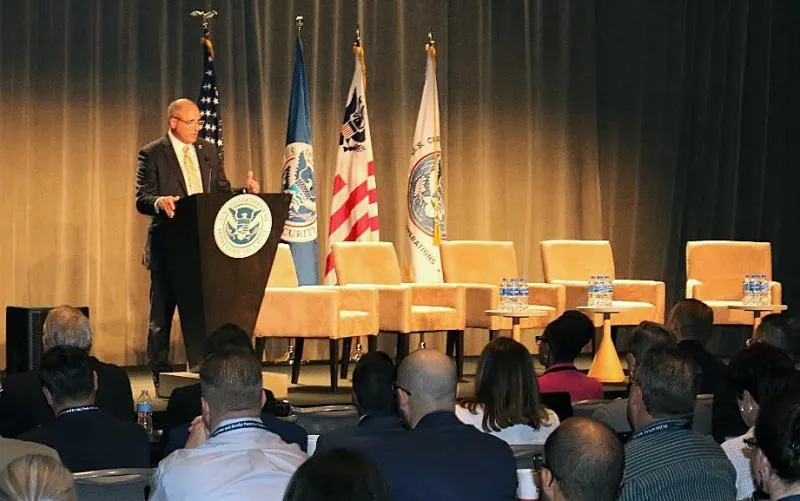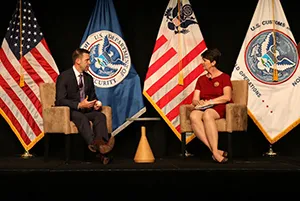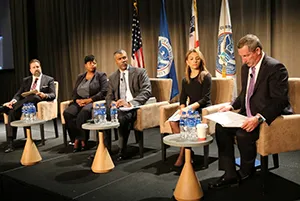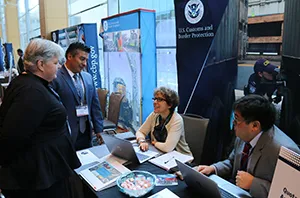Hoping to learn more about the constantly changing trade environment, a record-breaking crowd packed the halls of U.S. Customs and Border Protection’s Trade Symposium on July 23-24 in Chicago. Held at the Marriott Marquis, the event drew upwards of 1300 members of the trade community, who had their first opportunity to meet Acting CBP Commissioner Mark A. Morgan.
“I vow that I’m going to work as hard as I can to make sure that CBP continues to be close partners with the trade community,” said Morgan in his opening remarks, “and to seize every opportunity to address the challenges as they arise, and to do so with transparency, communication, and collaboration.”

attendees at CBP’s 2019 Trade Symposium, held
July 23-24, in Chicago. The event was Acting
Commissioner Morgan’s first public engagement with
the trade community. Photo Credit: Steven Bansbach
Morgan, a 32-year law enforcement veteran, who has previously served as the chief of the U.S. Border Patrol, the agency’s acting assistant commissioner for internal affairs, and deputy assistant director at the FBI among other positions, told the standing room only audience “I am 100 percent committed to ensuring that CBP is as transparent as possible. I intend to make sure that transparency is not just a goal. I want it to be part of CBP’s culture in everything that we do. We owe that to you.”
In the spirit of transparency, Morgan shared how the ongoing crisis along the Southwest border had impacted cross-border commerce. “The crisis that we are facing on the Southwest border is the largest magnitude that we have faced in modern history. It’s having an impact. It’s stretching our resources thin,” he said.
Morgan noted that over the last few months, hundreds of CBP officers had been deployed to assist at the Southwest border. In the first wave, 545 officers were sent from ports of entry along the Southwest border. “The initial reductions in the Southwest border staffing caused CBP to reduce the number of open lanes at some of the Southwest border ports of entry. These actions led to an increase in wait times. We know the criticality of this,” said Morgan, explaining that in response, CBP officers from various seaports, airports, and Northern border land ports were sent to backfill the individuals who had been removed from their Southwest border ports and allow them to return to their original assignments.
“The average commercial cargo wait time at the top 10 Southwest border ports is now down from 88 minutes to 25 minutes,” said Morgan. “I know the past few months have been painful for many of you. I promise we share that pain. We know that the stakes are high, so I pledge to you, I commit to you that we will share as much information as we can, and we will be as candid as possible.”
The border crisis was also one of the topics Acting Department of Homeland Security Secretary Kevin K. McAleenan discussed in a one-on-one conversation with Executive Assistant Commissioner Brenda Smith of CBP’s Office of Trade. McAleenan recognized that the migrant flows from Central America’s Northern Triangle countries--El Salvador, Guatemala, and Honduras—stemmed in part from economic trade barriers and appealed to the audience for help. “There are solutions out there and the trade community has a huge piece in it,” said McAleenan. “DHS and CBP are committed to providing the expertise, the training, the support to our partners in the region, but they need to hear from industry. U.S. industry, operating both in your economic interests and with your heart, can help change the dynamic in the region. It can also help the conversation here at home. These are vulnerable families and children that should not be in this cycle, in this situation. We need to work together to change this dynamic. This is a problem we have to solve.”

Commissioner Brenda Smith, right, leads a
conversation with Acting DHS Secretary
Kevin McAleenan at CBP’s Trade
Symposium held in Chicago, July 23-24.
Photo Credit: Steven Bansbach
The two-day event, held just days before the 230th anniversary of the U.S. Customs Service’s founding on July 31, 1789, featured a number of panel discussions. One of the most significant was a discussion on the Northern Triangle, where a panel, led by CBP’s Assistant Commissioner of International Affairs Ian Saunders, shared perspectives on potential government and non-government efforts to promote economic prosperity in the region.
“The conditions of the three countries are pretty extreme when you look at the limitations of infrastructure,” said Saunders. “We’ve been involved in programs in partnership with the Department of State and the U.S. Agency for International Development to improve the skill base of customs administrations using the World Trade Organization’s Trade Facilitation Agreement as an outline. That work began March of this year.”
Panelist Brian White, the director of global compliance, trade, and responsible sourcing for the J.M. Smucker Company, shared how CBP’s trade advisory group, the Commercial Customs Operations Advisory Committee, known as COAC, is trying to help the region. “In February, at our COAC public meeting, then-Commissioner McAleenan requested that a Northern Triangle working group be established to identify and develop recommendations on reducing nontariff trade barriers in the Northern Triangle,” said White, who serves as a COAC member.
Since February, the COAC and CBP have brought more than 50 different stakeholders together to review customs processes and challenges within the Northern Triangle as well as between the U.S. and the region. “We’re identifying investment opportunities for customs infrastructure development in the Northern Triangle as well as within Southern Mexico for trade routes,” said White. “We’re also working to develop an engagement strategy to encourage commercial stakeholders to conduct and invest in business in the region.”

perspectives on potential government and
non-government efforts to promote economic
prosperity in Central America’s Northern
Triangle region. From left, Brian White, Tasha
Reid Hippolyte, Ian Saunders, Kristie Pellecchia,
and Michael Dougherty.
Photo Credit: Steven Bansbach
Another panel discussion focused on e-commerce. “On any given day, we’re processing more than 1.3 million packages at international mail facilities. So that’s problematic. There’s no way that we can stop, inspect, or ensure that over a million packages are compliant. We need to rely on our partners and the larger trade community,” said panelist Thomas Overacker, the executive director of CBP’s Cargo & Conveyance Security Division.
Overacker explained that the total volume of packages had increased in all modes of transportation, but especially with express and air cargo. “This year the amount of airway bills transmitted to us is 134 percent from the same time last year. Not 34 percent, 134 percent. So that’s an explosive growth,” he said. “That’s a radical change from what we saw 10 years ago.”
Similarly, CBP is also seeing explosive growth in truck shipments. “We’ve seen a 74 percent increase in the number of truck bill manifests that we’ve received in the first three quarters of this year compared to the first three quarters of last year,” said Overacker. “We know that with the resources we have, we simply can’t inspect our way out of this. We’ll never have sufficient resources to inspect all of these packages.”
E-commerce was also one of the subjects discussed at a town hall-style panel where CBP’s senior leadership shared some of the agency’s significant developments. The official announcement of a new e-commerce pilot was one of them. The new pilot, known as “the 321 data pilot,” which was announced in the Federal Register Notice on the symposium’s opening day, was designed to help the agency with safety and security risk assessments.
“At the beginning, we’ll only be able to accommodate nine pilot participants, but we believe that the data that we will collect under the pilot will give us an opportunity to assess information about who is actually managing shipments outside the United States and who those shipments are going to here in the U.S.,” said CBP Executive Assistant Commissioner Brenda Smith.
Todd Owen, executive assistant commissioner of CBP’s Office of Field Operations spoke about advancements in nonintrusive inspection technology. During the last two years, CBP received $800 million in appropriations from Congress to update the agency’s nonintrusive inspection program. The large-scale inspection systems allow CBP to quickly inspect cargo and address border security concerns. They also facilitate the entry of low-risk shipments after they’ve been inspected. “It’s really the cornerstone to everything that we do on the inspection side of our ports of entry,” said Owen, noting that the systems are used to inspect trucks, cars, and buses. “We have about 280 large scale systems deployed throughout the country. About 118 of those are along the Southwest border, which is our greatest threat area. Fifty-seven are along the Northern border, and 105 are at our airports and seaports.”
According to Owen, the appropriated funds will be used to replace 51 systems that have gone beyond their lifecycle and an additional 181 new systems will be added. “Congress has recognized our need to not only replace a lot of our aging systems, but has enabled us to add more capacity at our ports of entry based on the demands of the growing economy.”
Moreover, the new technology allows CBP to scan trucks faster because the high-low energy settings of the system automatically adjusts and drivers can safely remain in their vehicles. “Right now, along the Southwest border, 77.3 million passenger vehicles come in every year and about 6.3 million trucks,” said Owen. “With the technology that we currently have, we can scan about one and a half percent of passenger vehicles and about 16 percent of the cargo trucks. With this new investment that Congress has given us over the last couple of years, by 2022, we’ll be scanning approximately 40 percent of the cars that are coming in and about 72 percent of the trucks. So this really will be a game changer for us in terms of meeting that security threat along the Southwest border and facilitating the entry of cargo and people.”

Produce Association of the Americas, and
Alfonso Valdes, logistics manager for Mar Bran,
one of the largest fruit and vegetable exporters
in Mexico, were among the more than 1300
attendees at CBP’s 2019 Trade Symposium
held in Chicago. Above, Moore and Valdes
stop to talk with Julie Peterson, center, and
Adam Malinowski at CBP’s Quota and
Agriculture booth. Photo Credit: Steven Bansbach
The symposium also featured notable speakers such as Department of Commerce Acting Under Secretary of Industry and Security Nazak Nikakhtar and U.S. Intellectual Property Enforcement Coordinator Vishal Amin, from the Executive Office of the President at the White House.
A number of breakout sessions were held on the second day of the Trade Symposium. One of the sessions focused on forced labor in the supply chain. “Forced labor is difficult to detect. You’re not going to be able to walk into a facility or go out to a location and see people being physically restrained or held against their will,” said Brian White from the J.M. Smucker Company, one of the panelists.
Instead, White shared three priority principles established by the Consumer Goods Forum, a global industry network that exchanges knowledge and initiatives. “The three priority principles are that every worker should have freedom of movement, no worker should have to pay for a job, and no worker should be indebted or coerced to work as part of his or her employment,” said White. “In 2016, all of the 400 retailers and manufacturers that are member companies of the Consumer Goods Forum adopted these principles. So at Smucker’s we’ve been really working to do that throughout our own operations as well as in our supply chain.”
One of the most popular breakout sessions was a rare opportunity for attendees to meet one-on-one with the directors of CBP’s Centers of Excellence and Expertise. All 10 of the industry-specific centers, which process the country’s imports, were represented. “A lot of companies are asking how they can find out which center they belong to, and then, who they should talk to within the center. We gave them the steps to be able to do that,” said Mel Moreland, the director of the Consumer Products & Mass Merchandising Center.
Many who attended the symposium said they found it worthwhile. For first-time attendee Brian Yochum, senior manager of logistics at Universal Lighting Technologies, a Nashville, Tennessee-based firm that designs componentry used in lighting fixtures, the symposium offered a way to learn more about tariffs. “I thought it would be good to see what’s shared here and get more information so we’re proactive in what we need to be doing to stay compliant,” said Yochum.
It was the second time Israel Morales had attended the CBP Trade Symposium. Morales, the trade compliance manager who oversees facilities in Mexico for construction equipment manufacturer Caterpillar, wanted to learn more about the current administration’s trade policies. “I work for an American company that does business in Mexico and we’re very interested in continuing to do business the right way because we see lots of potential to continue to grow regionally,” he said.
“This Symposium has gone over my expectations because I was able to hear directly from the administration—their views, their focus on trade policy, compliance, best practices, and ideas,” said Morales, who also is the director for foreign trade policy and foreign trade agreements for the National Maquiladora Export Manufacturers Association, or INDEX, which represents 1200 global companies that are predominantly American. “We understand that with the Trump administration many things are changing. The status quo or whatever we used to do is not the case anymore. So this was all very useful.”
Others who attended this year’s symposium have been at the event many times. “I keep coming back because it’s a good way to check in with what’s going on with the agency on a high level—priorities and new initiatives—as well as have some one-on-one discussions about some of the more technical issues impacting our industry,” said Allison Moore, vice president of the Fresh Produce Association of the Americas, a trade association whose members are U.S. companies that import fresh produce from Mexico and distribute it across the U.S., Canada, and Asia.
Of particular interest this year, Moore was looking forward to attending one of the breakout sessions on the Port of the Future, which featured new technologies and processes to enhance security and expedite legitimate trade. “We don’t want to be vulnerable to people trying to smuggle things into the country,” said Moore. “Anything we can do to work with CBP to strengthen and harden our supply chain security while still moving goods quickly and efficiently across the border is huge for us. We want to become less of an appetizing target for smugglers.”


